Abstract
Objective: To determine obstetrics and gynecology residents’ understanding of women’s health care advocacy and if participating in a two-part advocacy lecture series would improve their knowledge on the subject.
Study design: Obstetrics & gynecology residents at Albert Einstein College of Medicine/ Montefiore Medical Center were given a two-part advocacy lecture series with a pre- and post- lecture survey. Twenty three residents completed the pre-lecture survey and the post-lecture survey. Lecture content included a basic review of legislative processes and top National and New York State ACOG issues.
Results: The majority of residents felt that it is crucial to advocate for women’s health care needs (95% “somewhat/very important” before, 100% after lectures). As a result of the lecture series, more residents (26% before, 58% after) felt health advocacy training should be integrated into resident education (p=0.04). Residents with prior advocacy exposure felt more confident (63% “good/ excellent”) communicating about women’s health concerns versus those residents with no prior exposure (17% “good/ excellent”) (p=0.02). The lecture series increased awareness of top National ACOG issues (0% to 32%) (p=0.01) and top New York State issues (4% to 32%) (p=0.03). Residents cited “limited time” as the biggest barrier to participation in health care advocacy issues for women (89% of after group).
Conclusions: Participation in advocacy lectures appears to improve residents’ awareness of specific state and national health care advocacy issues. Overall, resident knowledge of health care advocacy is poor but interest in women’s health advocacy is substantial.
Key words
health care advocacy, residency education, women’s health
Introduction
Health care advocacy is an integral part of medicine and the principles of obstetrics and gynecology. It has long been recognized that the physician plays an important role in advocating on behalf of human health [1]. Supporting legislation to increase access to medical care or meeting with hospital administrators to improve health care quality has been suggested by some to meet the basic medical principle of beneficence [2]. To be effective health care advocates, future physicians will need formal educational training in health advocacy [3]. The 2013 Accreditation Council for Graduate Medical Education (ACGME) Common Program Requirements state “residents are expected to advocate for quality patient care and optimal patient care systems [4].”
Strong physician advocates are especially needed in the field of obstetrics and gynecology. An unprecedented number of bills attempting to regulate the provision of women’s health care have been seen in legislative sessions over the last several years [5,6]. In response, the American Congress of Obstetricians and Gynecologists (ACOG) urged its members to be women’s health advocates [7]. The Educational Objectives of the Council on Resident Education in Obstetrics and Gynecology (CREOG) states that obstetrics and gynecology residents should “advocate for the patient, women’s health, and the profession of obstetrics and gynecology” and should “recognize the role of the physician in legislative activities as they relate to women’s health policy [8].” Despite the recognition physician advocacy has received, to date, few studies have assessed women’s health advocacy knowledge for resident physicians [9-11]. In addition, little is known about how to effectively incorporate an advocacy curriculum into residency training [12].
Materials and methods
Obstetrics and gynecology residents (post graduate years 1-4) from an urban, academic residency program at Albert Einstein College of Medicine/Montefiore Medical Center in the Bronx, New York were given a two-part advocacy lecture series in 2012. Each of the two lectures were one hour in length and given two weeks apart. The lecture content included a basic review of legislative processes and top National and New York State ACOG issues. ACOG’s top legislative issues were identified under the “ACOG Legislative Priorities” section on the ACOG website. Prior to the first lecture, the residents completed a pre-lecture survey (Appendix 1). Residents were asked to complete the same survey immediately after the second lecture was completed. Of the forty-five obstetrics and gynecology residents at Einstein, twenty three completed both the pre-lecture survey and the post-lecture survey. One third of the residents were unable to participate due to night float or vacation schedules. Obstetrics and gynecology attending physician faculty members at Albert Einstein College of Medicine/ Montefiore Medical Center were asked to complete the same survey without being given the advocacy lecture series. Fifty three faculty members out of one hundred twenty sampled completed the survey. The majority were general obstetrician gynecologists (42.9%). Maternal fetal medicine (17.9%), gynecologic oncology (10.7%), reproductive endocrinology and infertility (8.9%), reproductive genetics (7.1%) minimally invasive gynecologic surgery (5.4%), and urogynecology (5.4%) faculty also participated in the survey. All surveys for both residents and faculty were completed anonymously. Participants were notified that by responding to the survey, they granted their consent to participate in this study. The Institutional Review Board at Albert Einstein College of Medicine approved this study.
Statistical analysis was completed by formatting each question as categorical data. Each question was summarized via its frequency and percent distribution. The association of 2 random variables was analyzed via Pearson’s χ2 test. In the event that the cell sizes were small, or there was significant departure from an asymptotic χ2 distribution, Fisher’s exact test was used and the p-value was estimated via Monte Carlo simulation. Odds ratios and 95% confidence intervals were reported for each association investigated. All statistical tests were performed in R and held at an α-level = 0.05.
Results
Defining health advocacy
Health advocacy is a broad term with variable meanings for different individuals. When asked to define health advocacy, resident and attending physicians expressed a variety of responses including “increasing access to care” and “promoting health services and education.” Residents and attending physicians also appear to be reading about a broad topic of issues related to health advocacy such as “access to family planning services,” “financing for graduate medical education,” “racial/ ethnic barriers,” and “improving access to prevention services.”
Resident physician knowledge
Only 17% of residents reported participating in health advocacy activities in residency, while 57% reported participating in medical school and 43% in college (Figure 1). Despite the lack of participation in residency, the majority of residents felt that it is crucial to advocate for women’s health care needs (95% “somewhat/very important” before, 100% after lectures).
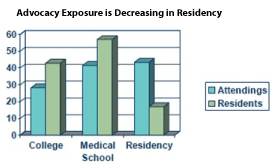
Figure 1. More attending physicians participated in health advocacy activities in residency (43%) compared to current residents (17%, p=0.02).
Prior to the lecture, few residents reported they had “good” awareness of health care advocacy resources. Post lecture there was a significant improvement in resident awareness of ACOG’s resources for advocating on behalf of underserved and vulnerable populations (4% “good” to 21% “good”) (p=0.03) (Figure 2). The lecture series increased awareness of top National ACOG issues (0% to 32%) (p=0.01) and top New York State issues (4% to 32%) (p= 0.03) (Figure 3). Most say they are “somewhat likely” or “very likely” to advocate for women’s health policy in the future, (91% before, 95% after lectures). As a result of the lecture series, more residents (26% before, 58% after) felt it “very important” to integrate advocacy training into resident education (p=0.04) (Figure 4). No residents reported a “lack of interest” to participating in advocacy issues for women after the lecture (26% before, 0% after) (p= 0.01) (Figure 5). Residents with prior advocacy exposure felt more confident (63% “good/ excellent”) communicating about women’s health concerns versus those residents with no prior exposure (17% “good/excellent”) (p=0.02) (Figure 6). Residents cited “limited time” as the biggest barrier to participation in health care advocacy issues for women (100% before lecture) followed by “unaware of how to get involved” (48% before lecture) and “lack of knowledge” (43% before lecture) (Figure 7).
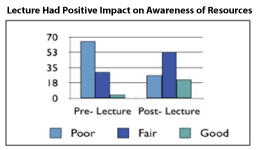
Figure 2. Post lecture there was a significant improvement in resident’s awareness of ACOG’S resources for advocating on behalf of underserved and vulnerable populations (p=0.03).
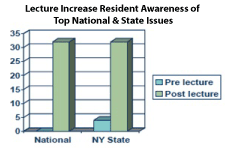
Figure 3. The lecture series increased resident awareness of top National ACOG issues (0% to 32%) (p=0.01) and top New York State issues (4% to 32%) (p=0.03).
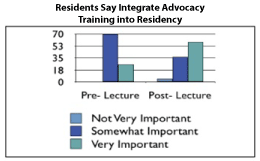
Figure 4. As a result of the lecture series, more residents felt Health Advocacy training should be integrated into resident education (p=0.04).
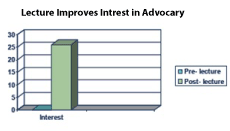
Figure 5. As a result of the lecture series, less residents reported “lack of interest” as a barrier to participating in advocacy issues for women (26% before, 0% after, p=0.01).
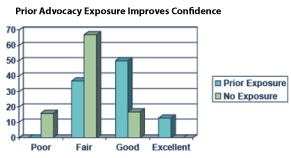
Figure 6. Residents with prior advocacy exposure (63%) felt more confident communicating about women’s health concerns versus those residents with no prior exposure (17%) (p=0.02).
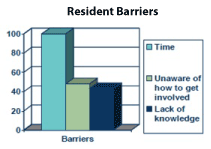
Figure 7. “Limited time” was listed by residents as the biggest barrier to participation in health care advocacy issues for woman (100%).
Attending physician knowledge
More attending physicians participated in health advocacy activities during their residency training (43%) compared to current residents (17%) (p=0.02) (Figure 1). Despite more exposure during residency, a majority of attending physicians still rate their awareness of ACOG’s resources for advocating on behalf of underserved and vulnerable populations as “fair/ poor” (55%) (Figure 8). The majority of attending physicians reported they did not know the top National ACOG issues (85%) or the top New York State issues (90%) (Figure 9). The majority of attending physicians (69%) report they are not currently involved in health advocacy activities (Figure 10). Out of the attending physicians who were exposed to advocacy during their formative years, the majority report they were influenced by role models (68%).
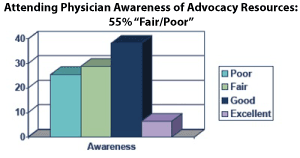
Figure 8. Attending physicians rated their awareness of ACOG’s resources for advocating on behalf of underserved & vulnerable populations.

Figure 9. Majority of attending physicians reported they did not know the top National ACOG issues (85%) or the top New York State issues (90%).
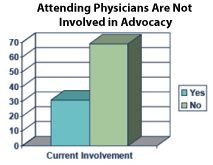
Figure 10. 69% of attending physicians report they are not currently involved in health advocacy activities.
Conclusions
There is a strong desire amongst obstetrics and gynecology residents to advocate on behalf of woman’s health care issues. Most feel it is important to advocate for the health care needs of women and to be involved in policy making and the legislative process. Despite their desire to be involved, the majority of obstetrics and gynecology residents do not participate in health advocacy activities and their knowledge on the subject is poor. Traditional lecture approaches to educating obstetrics and gynecology residents on health care advocacy did significantly improve their basic awareness and knowledge on advocacy. Although knowledge improved, overall, many residents still had a poor understanding of the subject and less than half knew ACOG’s top National and NY state issues post lecture. This demonstrates that health care advocacy is a complex topic that may be better learned in other approaches such as small group activities or hands-on experience.
Exposure to advocacy in residency appears to be decreasing over time. More attending physicians participated in health advocacy activities during their residency training compared to current residents. This is concerning as advocacy is part of the CREOG learning objectives as well as the ACGME’s common program requirements. Advocacy training in residency can also be argued to be important, as our residents who had advocacy exposure in the past reported higher confidence communicating about women’s health concerns. This may suggest physicians who are exposed to advocacy in residency will be the ones who feel more comfortable being advocates as practicing attending physicians in the future.
Lastly, attending physicians’ knowledge on advocacy was overall poor as well. The majority of attending physicians reported they were not currently involved in advocacy activities. Since the majority of attending physicians who were exposed to advocacy in the past reported their role models influenced them, this suggests that lack of attending physician involvement may have an impact on residency involvement. Increased education and awareness should be placed on engaging attending physicians involved with resident education and teaching in women’s health care advocacy.
Discussion
In April of 2017, an international “March for Science” was held. An organizer of the demonstration explained to NPR the mission of the march: “I think the profession of science is under attack. And why is that happening? Becasue we’ve really ceded the floor. We haven’t engaged in politics. We’ve left that open for politicians to come in and really hijack and obfuscate science for their own selfish needs [13].” The march organizer could have been speaking about obstetricians and gynecologists.
Increasingly, politicians are taking the medical-decision making process out of the hands of health care providers and their patients. Despite the growing challenges to the practice of medicine, physicians of women’s health must remain advocates for patients [14].
Historically, advocacy training has been sparse in the traditional medical school and residency curricula. Physicians are well-versed in acquiring scientific and medical knowledge to use for the practice of clinical medicine. Health advocacy is an under-developed skill set for health care professionals as illustrated by this study. America’s current political climate requires women’s health providers to urgently develop and utilize adocacy tools to influence institutional, commmunity and national policies [15].
ObGyns are uniquely positioned to advocate for issues related to women’s health and residency training is an ideal opportunity to strengthen and apply these skills. Teaching young physicians to build a framework to incorporate advocacy into daily practice on behalf of their patients is crucial.
“Advocacy” as an Educational Objective was introduced in the 10th edition of the Council on Resident Education in Obstetrics & Gynecology (CREOG) Educational Objectives in 2012 [8].
The CREOG Education Committee introduced Advocacy Educational Modules in 2015 for OBGyn Residency Programs as resources for curriculum development and resident education. The work presented in this paper and by others was instrumental in directing development of these modules and effectively incorporating an advocacy curriculum into residency training [16].
As public trust of physicians is great, there is an obligation to not only educate patients in the office setting, but also learn how to communicate effectively about women’s health concerns to the public. Engaging community organizations and participating in legislative activities as they relate to women should be seen as an essential role for the women’s health provider. Women’s health advocacy is particularly relevant during this year of political transition.
The Affordable Care Act (ACA) has provided no cost coverage of mandatory services for women aimed at improving health outcomes. As a result, access to prenatal care services, well woman visits, breastfeeding supplies and contraception has increased significantly since the ACA was signed into law in 2010. Weakening or repeal of the ACA threatens these provisions that are so important for women especially those in the underserved and vulnerable populations. Women’s health advocacy is more important than ever if progress in women’s health care is to be sustained [6].
Our research found that experienced physicians desired to play more of an advocacy role, but cited time contraints. Academic institutions as well as non-academic clincical practicies must make advocacy a priority, insuring experienced physicians have scheduled time to meet with legistlative representatives.
The data collected for this paper was presented in 2012 to the Legislative Committee of District II of the American Congress of Obstetricians and Gynecologists (ACOG) and New York State ObGyn residency program directors. While this study was small and more studies are needed to further assess this complex topic in the future, in 2013, ACOG District II formed the Resident Advocacy Program (RAP) to provide ObGyn residents of New York state the opportunity to learn about the policy process and meet with legislative representatives in the state capital, Albany, NY.
Hands-on advocacy experience provides a deeper understanding of issues and concepts and better prepares the next generation of women’s health phycisians to participate in the political process.
Health care advocacy should be considered part of comprehensive reproductive health care services delivered to patients. Engaging young ob/gyn physicians during residency training will improve their future participation as effective women’s health advocates. Traditional lectures improve resident awareness, knowledge and interest in health care advocacy.
Financial support
No financial support was used to conduct this study.
2021 Copyright OAT. All rights reserv
Conflict of interest
The authors report no conflict of interest.
IRB approval
This study was approved by the Institutional Review Board at Albert Einstein College of Medicine on August 23, 2012. IRB Project # 2012-1057.
Acknowledgment
Results of this study were presented in poster form at the 61st ACOG Annual Clinical Meeting, May 4-8, 2013, New Orleans, LA.
References
- Earnest MA, Wong SL, Federico SG (2010) Perspective: Physician advocacy: what is it and how do we do it? Acad Med 85: 63-67. [Crossref]
- Croft D, Jay SJ, Meslin EM, Gaffney MM, Odell JD (2012) Perspective: is it time for advocacy training in medical education? Acad Med 87: 1165-1170. [Crossref]
- Flynn L, Verma S (2008) Fundamental components of a curriculum for residents in health advocacy. Med Teach 30: e178-183. [Crossref]
- Accreditation Council for Graduate Medical Education Common Program Requirements. June 9, 2013; Available from: http://www.acgme.org/acgmeweb/Portals/0/dh_dutyhoursCommonPR07012007.pdf.
- Horvath-Cosper D (2012) Advocacy and the importance of supporting patients beyond the examination room. Obstet Gynecol 120: 918-919. [Crossref]
- Eisenberg DL, Leslie VC (2017) Threats to reproductive health care: time for obstetrician-gynecologists to get involved. Am J Obstet Gynecol 216: 256. [Crossref]
- Breeden JT (2012) Challenges, change, and relevance. Obstet Gynecol 120: 1-4. [Crossref]
- Council on Resident Education in Obstetrics and Gynecology Educational Objectives, A Core Curriculum in Obstetrics and Gynecology. 2013; 10th Edition. Available from: http://www.acog.org/~/media/Departments/Members%20Only/CREOG/CREOGEducationalObjectives.pdf?dmc=1.
- Stafford S, Sedlak T, Fok MC, Wong RY (2010) Evaluation of resident attitudes and self-reported competencies in health advocacy. BMC Med Educ 10: 82. [Crossref]
- Mu L, Shroff F, Dharamsi S (2011) Inspiring health advocacy in family medicine: a qualitative study. Educ Health (Abingdon) 24: 534. [Crossref]
- Hufford L, West DC, Paterniti DA, Pan RJ (2009) Community-based advocacy training: applying asset-based community development in resident education. Acad Med 84: 765-770. [Crossref]
- Verma S, Flynn L, Seguin R (2005) Faculty's and residents' perceptions of teaching and evaluating the role of health advocate: a study at one Canadian university. Acad Med 80: 103-108. [Crossref]
- National Public Radio (NPR), An Organizer Speaks About Reasons for a March for Science (Lucky Tran). April 23, 2017.
- American College of Obstetricians and Gynecologists and American Congress of Obstetricians and Gynecologists. Restrictions to Comprehensive Reproductive Health Care. Position Statement. April 2016.
- Tracy E (2011) Three Is a Crowd: The New Doctor-Patient-Policymaker Relationship. Obstet Gynecol 118: 1164-1168. [Crossref]
- Council on Resident Education in Obstetrics and Gynecology, Advocacy Educational Modules. Available from: http://www.acog.org/About-ACOG/ACOG Departments/CREOG/CREOG-Search/Advocacy-Modules










